Choosing a mountain bike can seem like a complicated decision, there are duallys, hardtails, fatties, some with suspension, some without, different wheel sizes and frame materials, the options seem to know no bounds. To make things a little easier, and help cut through all the terminology, we've put together this buyer's guide to explain the different types of mountain bikes, the type of riding you can do with them, and just how to choose the right one for you.
[externalhotoffer group="EHO_1"]
Types of mountain bikes
Although mountain bikes fall under one banner like road bikes, the type and purpose of each bike can be worlds apart. Unlike road bikes which are all ridden on the road and don't change much regardless of the profile, mountain bikes are tailor made for specific terrain and riding styles.
Some bikes feature generous suspension front and back to deal with extremely rough trails; others don't have any suspension at all to be stiffer, lighter and faster on smooth trails; while others have limited suspension in an attempt to find the right balance between speed and support. And then there are new sub-classes of mountain bikes, such as 'Fat' bikes for tackling sand and snow.
Each bike will have differing head tube angles depending on whether their focus centers around handling or stability. Bikes with a steep head tube (69 to 71 degrees) angle provide more responsive handling and are considered to climb better, whereas a slacker head tube angle (<68 degrees) will provide more stability at high speed.
Below is a description of each bike and what they are built for.
Dual-suspension / Full suspension
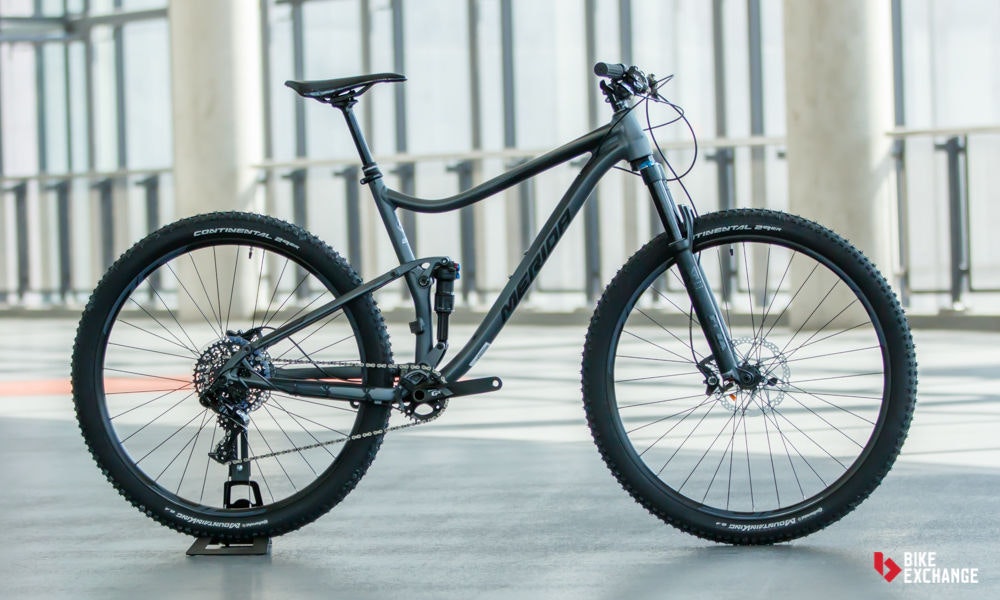
As the name suggests, dual-suspension or full suspension mountain bikes have suspension in the front and rear of the bike. The suspension systems allow for 'travel' which is mountain bike terminology for the amount of suspension movement available. The suspension helps absorb the impact from the trails, reducing the impact on the rider and improving traction and comfort. The suspension helps keep the wheels on the ground for traction, as a result, the rougher the trail, the more suspension required. Typically travel will range from 80 mm - 200 mm front and rear, depending on the intended purpose of the bike.
Downhill bikes for example are built to go down steep, technical tracks as fast as possible, so have large amounts of travel to provide additional traction and support. At the opposite end, cross country bikes need to be light and efficient to pedal and so will typically feature around 100mm of travel. Many suspension systems allow riders to 'lock out' the suspension which effectively renders the shocks inactive, consequently reducing movement and making the bike stiffer which is better for climbing back up to the top of the mountain or riding on the road to the trail head.
A quick guide on suspension
The front suspension is located in the forks and is relatively simple in comparison to the rear suspension which comes in a variety of forms.
Suspension in the fork is provided by a spring which 'bounces' open after it has been compressed from hitting an obstacle along the trail. The spring can be either air, coil or both. Air springs are light weight and highly tuneable using a shock pump. Coil springs are used on lower cost bikes and also feature on downhill or gravity bikes. Made from either steel or titanium, the coil springs are extremely durable, providing a more responsive feel than air springs due to a lack of tight seals.
Rear suspension comes in many forms. All try to achieve similar things, which is to isolate braking and pedaling forces from the suspension action. The Four Bar system is perhaps the most common and features a chainstay pivot, a pivot behind the bottom bracket and a pivot on top of the seat stay which is connected to a leveraged shock linkage. The Faux Bar system is very similar to the Four Bar but with pivots on the seat stays. A variation on the Four Bar is the Virtual Pivot Point (or VPP) and the DW-Link which both use twin links to isolate the rear end. A Split Pivot has a rear dropout pivot placed in line with the rear wheel axle, and is virtually the same as Trek's Active Braking Pivot (ABP). A single pivot suspension system is the most simple option featuring a swing arm and one main pivot located above and forward of the bottom bracket. The Floating Drivetrain so called because the drivetrain is positioned on a link between the front and rear triangles is another popular system.
All of these systems have pro's and con's, and is sometimes dependent upon the manufacturer as to which system you'll get.
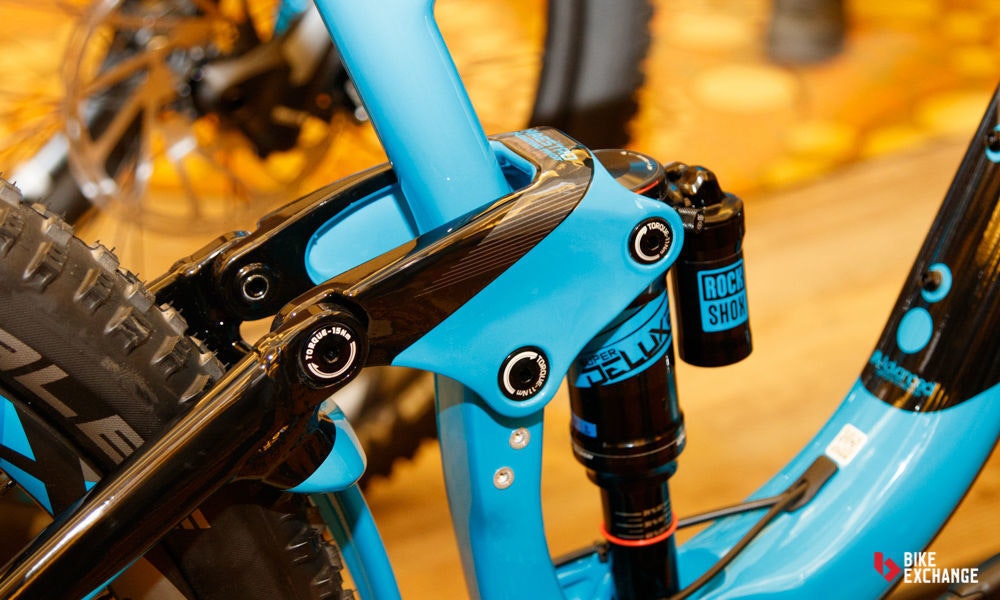
Hardtail
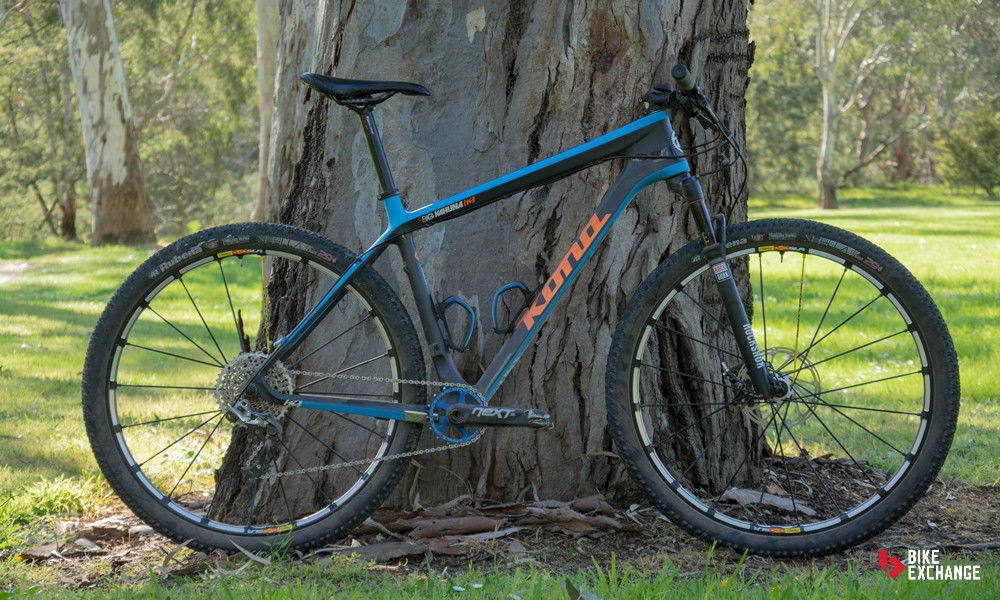
Once again the name of the bike gives away its unique feature. Hardtail mountain bikes only have suspension in the front of the bike and no suspension in the rear, creating a 'hard tail'. As hardtails have less moving parts they are typically lighter and more affordable than dual-suspension mountain bikes, and require less maintenance. As with dual suspension lock out systems, the front suspension mechanism on hardtail bikes can also be locked, effectively creating a fully rigid bike.
The lightweight and stiff nature of hardtails make them suited to less challenging trails and cross country riders who are chasing speed. The limited suspension still offers plenty of comfort, so aside from the roughest of trails or steep downhill sections, hardtails are well suited to a variety of different off-road trails.
Rigid
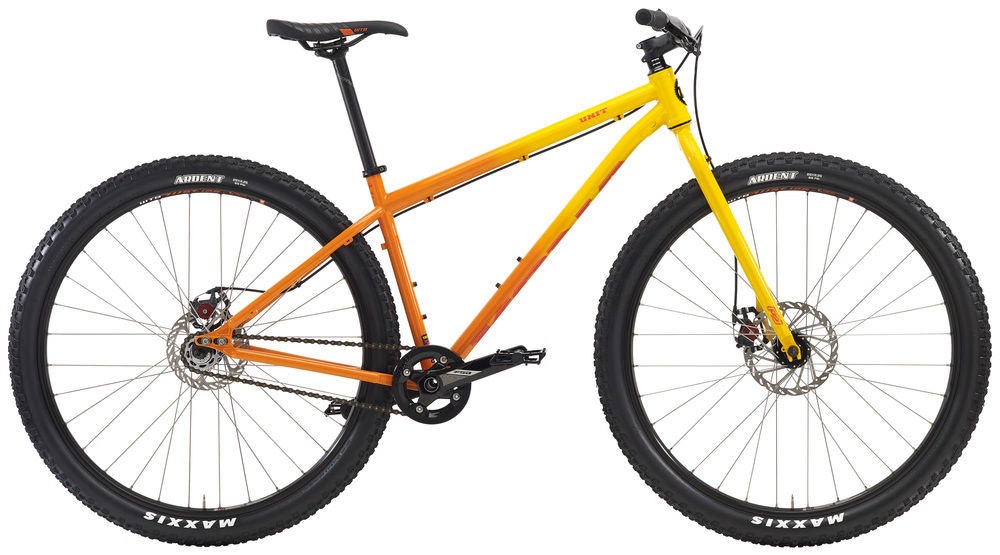
Mountain bikes with no suspension at all are referred to as 'rigid' bikes. The lack of suspension limits the potential usage of rigid bikes to easier trails, with the tires providing the majority of the comfort.
The lack of suspension makes rigid bikes lighter, and with less moving parts they are also cheaper then hardtails and dual-suspension bikes. They also require little maintenance in comparison to their suspension equipped brothers. However, advancements in suspension design and typically lower costs means rigid bikes are becoming less common and are typically now only sold in niche categories.
Type of riding
The various mountain bike disciplines all require specific features on the bikes to achieve an optimal outcome. For example, lightweight bikes excel in Cross-Country (XC) racing , so a light weight frame and components are highly sort after. For other disciplines like Trail, All-mountain or Enduro racing, a bike with longer travel and a dropper seatpost is popular.
To help you decide on what kind of bike you should be looking for and with what kind of features, here's a summary of the common forms of mountain bike riding
Cross-Country
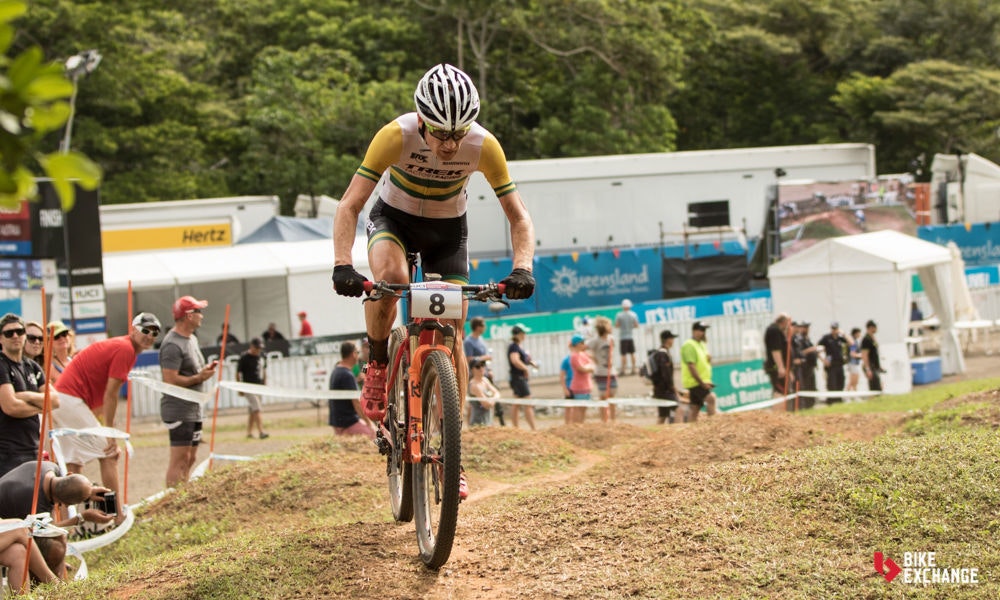
This is the 'original' form of mountain bike riding and is done on naturally occurring trails or trails that have been purpose-built. The terrain can be almost anything – hard-packed, muddy, rocky, gravel, tree roots, soft from vegetation. Along the way you might come across naturally-occurring obstacles, or in the case of trail centers you’ll also encounter man-made challenges (seesaws, bridges, jumps etc) specifically placed along the path to make things interesting!
Trail centers, which have either been enhanced, altered, maintained by human influence, may be graded as per the degree of technical proficiency required to ride the course. Green gives you a pleasant family-style journey, blue indicates the path is rollable (no major obstacles to get over). Red is for more technical riding and black is for challenging paths – bigger drops, obstacles in your path, gaps, etc – the stuff for serious riders.
XC also refers to common types of racing, with the two most common forms being 'XCM' and 'XCO'. XCO refers to Cross Country Olympic, an Olympic sport that typically consists of 1-2 hour long races held on technical and hilly loop courses. XCM stands for cross country marathon, with races covering varying terrain for distances ranging from 50 to 150+km in length.
Almost any kind of mountain bike is suited to cross country due to the variety of graded trails. Hardtails can easily cover green and blue trails, but as you move further into red and black trails, suspension becomes increasingly important. For these tougher trails, dual-suspension mountain bikes with 90 - 120 mm of travel are great options. Cross country courses require a lot of pedaling, so a drivetrain that is lightweight and efficient is also an item to be ticked off. Tyre size will also depend on the type of trail you're riding but either 26in, 27.5in or 29in will get the job done. Head tube angles will vary, bikes more focused on speed and technical trails will have a steeper head tube angle to provide fast, responsive handling.
Trail
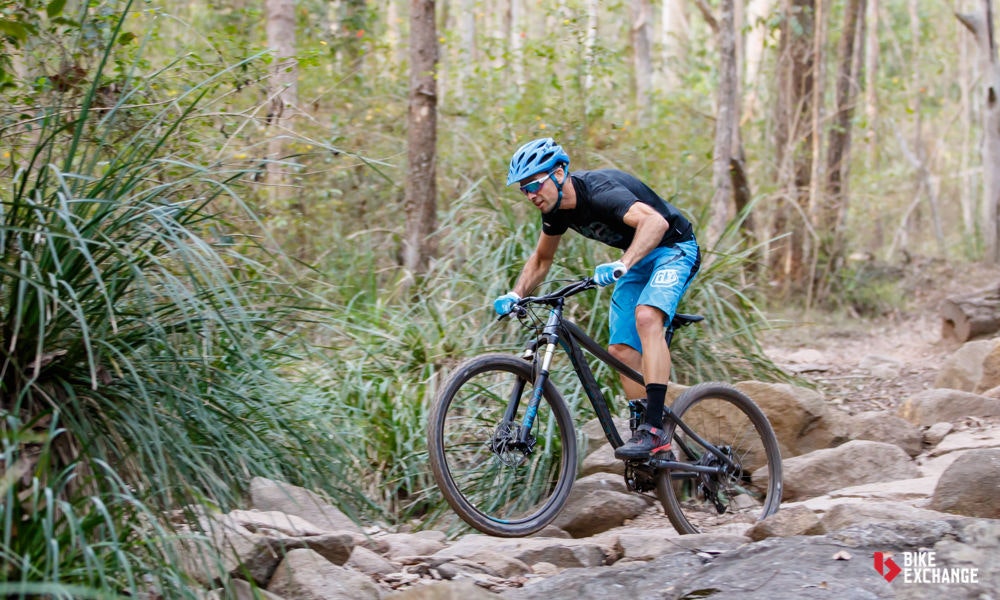
Trail riding is arguably the non-racing aspect of cross country riding. This is simply 'mountain biking' to many and will generally cover trails with greater technical difficulty than those designed for cross country.
A trail bike sits somewhere between a bike designed for cross country and Enduro racing. These are designed to perfectly balance both climbing and descending, a jack of all trades if you will. Many trail bikes can be raced in cross country events, but may be heavier and slower on climbs.
Dual suspension bikes with 120 -140 mm of suspension travel will perform well on any trail, and as with cross country riding, 27.5in or 29in wheels will work well. Given the extensive range of trails you can encounter, a drivetrain with a large gear range is something to look out for. The head tube angle will again vary on the level you plan to be riding at, but generally will be slacker than cross country bikes with angles somewhere between 67 and 69-degrees.
Enduro / All mountain
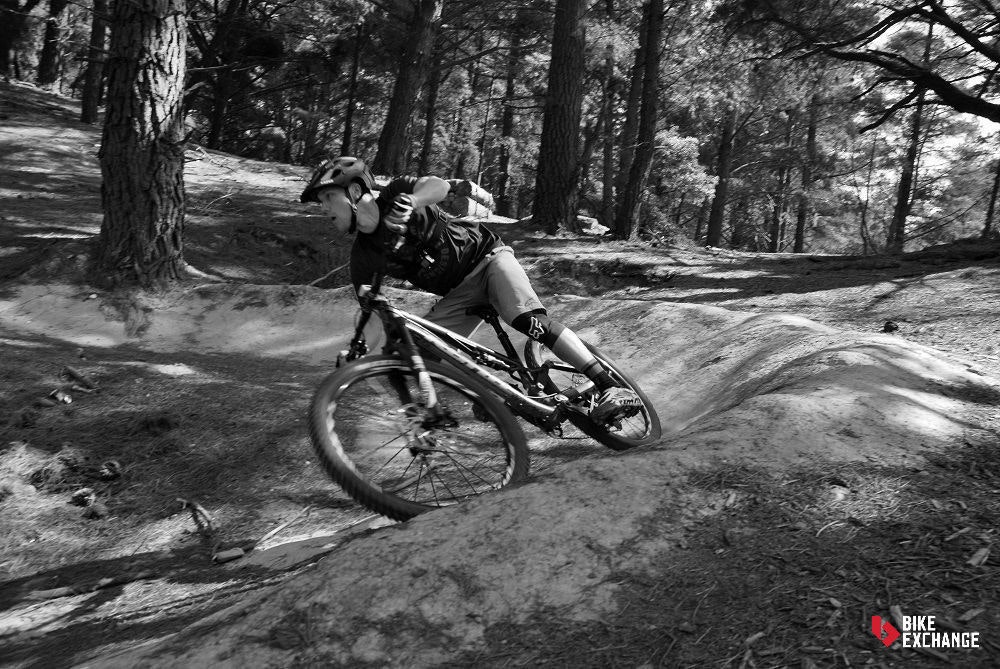
Enduro riding is a unique form of mountain biking where downhill sections of a course are timed, but the uphill sections are not. The stage race format rewards the rider with the lowest accumulated time for a set number of downhill runs. Although the uphill sections aren't timed, on many occasions there are time cut-offs to adhere to.
Enduro is one of the fastest growing disciplines in mountain biking. The jumps are more challenging, the drops are bigger, and the trails are more likely to be black level.
Enduro bikes are designed to take the rider uphill, but then shine on descents. Look for a bike with 140-170 mm of suspension travel front and rear, a 'dropper (height adjustable) seat post and tires of 2.3in width or larger. The headtube angle will be slacker than that of trail bikes, but slightly steeper than downhill bikes so that the trek back up with mountain is more manageable.
Gravity / Downhill
One for the adrenaline junkies, as the name suggests, this type of mountain biking is all about flying down. Riders will either get a lift up to a certain mountain point, or they’ll sometimes even walk up with the bike. Ski resorts around the world are starting to operate chairlifts throughout the year – not just during the snow season – which makes downhill riding a more accessible. Once at the top, it’s all about getting down to the bottom of the hill as fast as possible while handling the drops and jumps, gaps and rocks, slips and slides as you go.
For this type of riding you’re looking at a bike designed for the descents and little more. Look for a bike with front and rear suspension travel between 170 - 210mm, a long wheelbase for high speed stability, secure hydraulic disc brakes and tires at around 2.5in in width. Gears don't matter as much, with the top pro's typically racing with just seven. 27.5in wheels have overtaken 26in as the new standard for this type of bike. The head tube angle for downhill bikes is the slackest of all mountain bikes, at about 62-65-degrees, to account for the high speed and stability required.
Don't forget to budget for body protection when doing this type of mountain biking. A moto-style full face helmet, goggles, and knee protection are typically sound investments.
Wheels
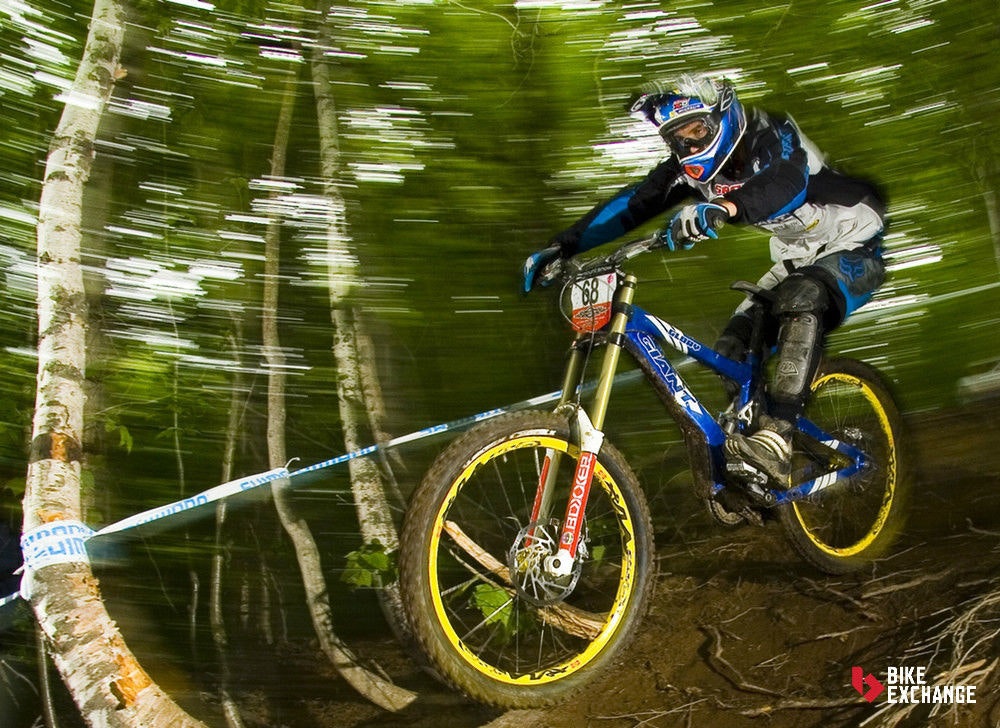
There are three main types of mountain bike wheels that you will find on the majority of new mountain bikes, plus larger options to cater for specific bikes.
Wheels are referred to by numbers which indicate their size. 26in wheels were the original mountain bike wheel size and are still used sparingly today thanks to being nimble and light. The shift in recent years has been to larger wheels that offer more traction and a better ride quality so 26in wheels are rarely seen on new mountain bikes.
27.5in wheels are sometimes referred to as '650B' and have essentially replaced the 26in wheels. These wheels offer slightly improved roll-over ability, traction and air volume than 26in wheels. 27.5in wheels are lighter, stronger and typically more nimble than the 29in wheel size so depending on the type of riding you do, these might be a good option.
29in wheels are also called '29ers' and thanks to their increased size, they provide more traction, greater roll-over ability on technical obstacles and a smoother ride from increased air volume. 29er wheels have become the most popular choice in many mountain bike disciplines. Their increased stability also means they’re good on the descent. They do, however, weigh more than the smaller wheel sizes, can be cumbersome in small frame sizes and are slightly limited in the amount of suspension that can be incorporated around them. For this, 29er bikes are best used in cross country and trail-type riding, where generous suspension travel is usually not needed - although this is fast changing as many of the world's best enduro bikes are now being offered in 29in wheels too.
All of these wheel options also come in plus sized wheels. These wheels sit somewhere between normal and fat and claim to offer improved traction, control and comfort over a standard wheel. Offering a large volume 2.8 to 3in width, Plus Sized wheels are available in either 26, 27.5 and 29in rim diameters but add further height beyond that. For example, a 27.5+ tire measures close in diameter to a standard 29er tire.
Fat bikes require specific wheels that are hugely oversized to provide comfort without requiring suspension and enough traction to cover sand and snow. Fat bikes have increased tire clearance to handle tires ranging from 3.5in to 5.5 in in width.
Budget
So now that you know what type of mountain bikes there are to choose from, paired with what type of wheel size will suit you, it's time to find out what kind of price range you're looking at to get the perfect bike for you.
Mountain bikes start at as little as USD$200 and can extend to over USD$8,000 for all the bells and whistles. Regardless of your price range you can pick up a great bike that will serve your purpose. Spending more money on a bike will typically (but not always) result in a reduction of weight, better suspension, improved shift quality, increased durability and greater comfort.
The materials of the bike's frame and fork will change as the price increases, typically moving from steel to aluminium to carbon fiber. Groupsets will have a similar progression starting with low grade alloys, then progressing to higher grade allows, then a mix of the highest grade alloys, carbon fiber and titanium. Wheelsets follow a similar path from aluminium to carbon fiber. Due to additional moving parts and technology required, suspension systems increase the price of a bike, dual-suspension bikes with large amounts of travel generally the most expensive.
Below is a summary of what you can expect within a set budget.
Under $500
This price range is targeted at recreational riders, families and beginner riders. Often the term 'mountain bike' is a descriptor of the bike's aesthetic, and so a bike of this price may not actually be designed for off-road use at all. At most, bikes of this price are capable of tackling smoother, well maintained dirt trails. The frame is likely to be made from aluminium or steel and highly durable, but it's the parts that are likely not up to the task.
Although dual-suspension mountain bikes are available at this price it's best to steer clear of them in favor for a hardtail or rigid bike. Suspension systems are highly complicated and require quality components to work effectively, be durable and reliable, and that's too much to ask for under $500. Any dual-suspension mountain bikes under $500 are likely to be much heavier than a hardtail or rigid option, and unless you're planning on hitting some heavy trails, they will do a good enough job.
Cable rim and disc brakes are both an option here, disc brakes the preferred option as they perform better in wet. It is unlikely to find hydraulic disc brakes at this price, they typically become available in the next price bracket.
Gear ranges will typically be smaller than more expensive bikes as it's assumed you won't be climbing any significant hills. Wheels are typically both heavy and weak at this price point.
Between $500 - $1,000
Good news for entry level riders looking to cover basic trails. A good hardtail becomes accessible at this price point, as do hydraulic disc brakes. Hydraulic brakes require less maintenance and provide more power and better modulation.
The frame will be a little lighter and likely made of aluminium. You should be looking for a 8-speed cassette as a minimum, most likely paired with a double or triple crankset up front. Tires will also improve having a better tread profile for proper trails and being more supple improving ride quality and performance.
You may be able to find a dual-suspension mountain bike at this price point, but they will still be far heavier and less durable than a good hardtail, so it's worth holding off until the budget can stretch a little further.
Between $1,000 - $2,000
For those looking for a dual-suspension mountain bike, this is the place to start. The welcome addition of suspension front and back does come at a trade off to quality parts. A hardtail at the same price will typically have better quality componentry, but obviously sacrifices the rear suspension. So the question at this price point becomes which do you favor, a dual-suspension for comfort and the ability to hit some solid trails, or a hardtail with higher quality components that is going to perform better on less technical trails. Hydraulic disc brakes are almost standard as is an aluminium frame.
One thing we haven't spoken about is thru-axle fork vs a quick release system. Thru-axle forks have a larger diameter axle which improves stiffness and steering as a result. You'll find them on bikes at the upper end of this price point, and more commonly above it.
An extra gear or two should be on offer, now 10-speed is common and most likely still paired with either a double or triple crankset.
Tubeless tires are an interesting topic at this price, Trek supplies 'tubeless-ready’ rims on just about every bike over $600 USD but other brands may require you to spend closer to $3,000 to get it them. It's a great upgrade to your bike and so it's worth asking about.
Between $2,000 - $3,500
Things really start to become interesting at this price point with many features becoming accessible such as dropper posts, 1x drivetrains, and we start to see carbon frames. Bikes become distinctively split between disciplines at this stage, and you'll begin to see specific drivetrains for downhill events that don't require the range that cross-country bikes do.
Hardtails become available in carbon creating a lighter, stiffer and more responsive ride. The decision between a carbon hardtail with quality components over a dual-suspension alloy bike with lesser components becomes a tough one. No doubt the extra comfort and support on rough trails would be welcome, but a good quality hardtail may do just as good a job depending on the type of riding you have planned.
$2,000 is the approximate entry for a bike with a dropper seat post (Adjustable seat height at the flick of a switch) which will make descents easier by lowering your center of gravity.
You'll begin to see many 1x drivetrain options where the front derailleur is removed to reduce weight and simplify the shifting process without sacrificing too much gear range. Having a 1x drivetrain reduces the amount of moving parts and the amount of potential mechanical issues as a result. It also allows manufacturer's to experiment with frame design, creating bikes with greater tire clearance and shorter chain stays which helps create a more nimble bike with better traction and control.
Between $3,500 - $6,000
If the budget will stretch, this is where you get almost everything a mountain bike has to offer; lightweight frame, high quality components, tubeless-ready rims, dropper post, hydraulic disc brakes, thru-axle front and rear, and either a SRAM x1 or Shimano XT drivetrain.
Suspension systems become highly sophisticated allowing you to adjust the feel with external adjusters and an air pump (known as a shock pump). Brakes are likely to provide a perfect balance of modulation and power for extra confidence. Gear ranges are likely to be much larger in this price range to cater for a variety of trails and make even the steepest climbs manageable.
Above $6,000
At this price point mountain bikes go Gucci and highly specialized. Expect a lightweight carbon fiber frame from a desirable brand, light and strong carbon fiber wheels, top-tier components, Shimano electronic drivetrain or SRAM x1 with 12 gears. Splitting performance at this price range becomes difficult as the difference between one bike and another is often minimal, so it really comes down to rider preferences or desires.
Frame material
As with road bikes, mountain bikes are commonly made from either carbon fiber, aluminium, titanium, steel or a combination of these materials. Each material has different characteristics and will affect the cost, comfort, weight and general 'feel' of the bike. It's worth noting that it's often how the chosen material is used by the engineers and manufacturers that matters most, and this is something that each brand will typically play with.
Aluminium is the most common frame material closely followed by carbon fiber. Aluminium shares similar properties to carbon fiber; it can be used to make a light and stiff bike. It's also easier to work with, which makes it a cheaper option than carbon fiber. Aluminium bikes have great power transfer thanks to the stiffness of the material and thickness of the tubes, but this can lead to a harsh ride if suspension isn't present. To add strength to an aluminium frame whilst keeping weight down, manufacturers will add 'butting' in single, double or triple variations to the frame tubes. This involves producing tubes with varying wall thicknesses which become thinner in the center where strength isn't as crucial as it is at the welded ends. For example, a triple butted tube will change wall thickness three times and therefore can be made lighter without a loss in strength, but at an increased cost. Choosing an aluminium frame can provide a cost effective solution for those seeking performance on a budget.
Carbon fiber was once found exclusively in the professional ranks due to its high cost and difficulty to work with. Over time the price has come down, manufacturing processes have improved and it is now common to see carbon fiber mountain bikes. Carbon fiber is now easier to work with, is directional in its nature and can easily be molded into any shape enabling manufacturers to experiment with tube profiles and frame shape.The stiffness to weight ratio of carbon fiber is the best of any material used for bikes which is why it is the universally chosen material for bikes in the professional ranks. The downfall of carbon fiber is it can crack under excessive stress to an area such as impact from a crash or over tightening screws. Once the integrity of the carbon has failed, the material can become extremely fragile and dangerous to use. At this point it either needs to be repaired or replaced.
Steel is a common material used in entry-level bikes. Steel is strong and relatively inexpensive but weighs more than aluminium and carbon fiber frames. Before aluminium and carbon fiber, steel was the material of choice for mountain bikes, both recreational and professional. Modern, premium steels can be quite expensive and laborious to use and so lost favor with many brands choosing other materials that offered greater stiffness to weight ratios.
Titanium is rarely used on mountain bikes due to it's high cost. Titanium is relatively light weight, highly durable and won't corrode like steel. Unlike carbon fiber and aluminium that can easily be molded, titanium is hard to work with which makes it an expensive material choice. Titanium has a distinct advantage over aluminium and carbon fiber in that it's incredibly resilient in the event of a crash. It takes a lot to damage titanium which is why people choose it as a lifetime luxury purchase. As well as being durable, titanium frames are comfortable and with new machining techniques the tubes can be made very thin enabling the weight to be kept low.
Groupset
A groupset comprises of brakes and the drivetrain which is thought of as the bike's engine room. The drivetrain consists of the cranks, chain rings, chain, cassette, derailleurs and shifters. The drivetrain is a closed circuit which propels the bike and as you spend more money, the efficiency, durability and shifting performance increases while the weight decreases.
As you work up the groupset hierarchy, the materials change. Entry level groupsets are made up of mostly low-grade alloys which move to the higher-grade alloys, and then the highest-grade alloys, carbon fiber and titanium for the top-of-the-line options. As mentioned above, bikes over a certain price will move to a 1x drivetrain option with either 11 or 12 gears, and electronic drivetrains are available too.
Mountain bike groupsets are far more complex than road bikes due to the different demands of each riding style and often groupsets are made up of a mixture of component grades and brands. Choice of frame, wheel size and type of riding will dictate the amount of gears on the cassette, type of crankset, brakes, shifters and derailleurs.
Cranksets are available as a triple, double or single. A triple crankset will normally have a 44/34/24 or 42/32/22 ratio which provides a large range of gears but has considerable cross over and the potential for mechanical issue with more moving parts. A double crankset is more common these days and will normally have a large chain ring with 36 - 42T, and a small chain ring with 24 - 28T. The double crankset offers similar gear ratios to a triple but with fewer parts, and so is lighter and provides better chain angle for improved efficiency. A recent trend is the 1x or 'one-by' drivetrains whereby the front derailleur is removed and there is only a single chain ring on the front. This further reduces moving parts, reduces weight and in some cases still provides similar gear range to a double crankset.
Given the different crankset options available and different kinds of trails, the cassettes on mountain bikes vary dramatically. Ratios can be similar to a road bike at 11-32, or as large as 10-50 for the latest 1x SRAM Eagle 12-speed drivetrains.
Type and quality of brakes will differ from groupset to groupset. There are two common brake types available in modern mountain bikes. These are cable operated disc brakes and hydraulic disc brakes. Cable operated disc brakes will typically feature on entry level bikes, while hydraulic disc brakes will typically feature on any mountain bike over $600 USD. Hydraulic systems are deemed superior as they're based on automotive technology that produces a lightweight, reliable and low maintenance system with fantastic brake control. As with most other elements of the groupsets, as the price increases so do the quality of materials used, which provides lower weight, better modulation (brake control), durability and reliability. Once the only choice, rim brakes do exist in mountain bikes, but will only be found on the very cheapest of new bike options.
Shimano and SRAM are the two major brands proving groupsets for mountain bikes, below is a summary of their mountain groupset line-up.
Shimano

Shimano has an enormous line-up of mountain bike groupsets ranging from the entry level 'Tourney' to the elite 'XTR Di2'.
Tourney and Altus are the introductory groupsets from Shimano that are found on kids mountain bikes and mountain bikes under $500 USD. They are suited to recreational riding but true off-road riding is probably beyond these two options. Both groupsets will most likely have a triple crankset and feature either 6, 7, 8 or 9-speed cassette.
Acera is most likely to be found on entry level rigid or hardtail bikes. The components are more durable and corrosion resistant, an essential feature for anyone planning to go off-road and ride in anything less than ideal conditions. Alivio is a significant step up for Acera featuring 9-speed cassette, hydraulic disc brakes, multiple crankset options and a reduction in weight. Alivio is most likely to be seen on rigid and hardtail bikes, and possibly on some entry level dual-suspension bikes too.
Similar to Sora or Tiagra in road riding, Deore is considered the first real step into 'proper' mountain biking. The groupset is still considered entry-level but features many attributes of higher tier groupsets. Deore has either 9 or 10-speed gearing options that can be paired with a double or triple crankset. For the majority of riders, Deore has everything you'll ever need with reliable and durable components and a big step up in braking.
This guide has discussed in depth the different types of riding options, and Zee is the first specialized groupset, targeting specifically downhill racing. Zee features much of the same technology as the top tier downhill groupset Saint does, but is heavier and uses less expensive materials. Saint is positioned for elite downhill riders chasing victory. Both groupsets have only a single chain ring on the front as a wide gear range is not required when you're only riding downhill.
If Deore is the mountain bike equivalent of Tiagra, then SLX is the mountain equivalent of Shimano's 105 road group. SLX offers almost the same features as the hugely popular XT but weighs slightly more, is made from less expensive materials and provides marginally slower shifts. Mountain bikes equipped with SLX will perform well on almost any trail and is suitable for a wide range of riding abilities. SLX is available in 10 or 11-speed, and the new 1x11 SLX groupset is a popular choice on 2017 mountain bikes.
Beyond SLX, Shimano's groupsets move deep into the high performance category, beginning with XT, XTR and then XTR Di2. All of these groupsets are made with high quality materials, reduce weight over other groupsets, are durable and provide excellent shift speed and quality. XT is available in single, double and triple cranksets which feature high grade alloys.
XTR saves a little weight over XT, and electronic shifting is introduced with the XTR Di2. The electronic groupset isn't susceptible to reduced performance in the mud and dirt like mechanical systems. Riders can now virtually change gears automatically with Syncro shift, which automatically adjusts the front derailleur depending on gear selected on the rear, and can also program shift buttons to change multiple gears at the press of a button. The system is slightly heavier than XTR but for the performance gains and flawless shift quality, it's a small price to pay.
As with the road groupsets, Shimano products are made to work with each other so as long as the components share the same number of gears they can be swapped, mixing SLX with XT for example.
SRAM

SRAM make a clear differentiation in their groupsets between 1x and regular double or triple crankset options. They were the innovators with the double drivetrain, and have driven the shift to 1x drivetrains which they say will eventually be the only groupset option on mountain bikes.
X5 is the first complete groupset offered by SRAM and launches straight into a 10-speed gearing system with a double or triple crankset. X5 is most likely to be seen on entry level hardtails bikes and even has a specific crank for Fat bikes. The crank arms are only available in 170 and 175mm but there are multiple chain ring options; 42.28, 39/26, 38/24, 36-22T and 44-33-22T for the triple. The 10-speed cassette is an 11-36 providing a huge gear range.
The next groupset from SRAM, X7 can be found on entry level dual-suspension bikes as well as hardtails. Like most lower-tier groupsets, it features similar technology as the top-tier options, albeit with less expensive materials and extra weight, the rear derailleur and shifters feature the same technology as the X0 and X9 2x10 drivetrains. X7 features the same chain ring ratios and 11-36T cassette as the X5, but gets an additional 180 mm crankarm option.
X9 is next in the hierarchy and is the equivalent of Shimano's SLX, a reliable, durable groupset with many features of the top-tier groupsets. As with SLX, money is saved on the X9 by using less expensive materials which adds a little weight but comparable performance features.
2017 entry to intermediate level mountain bikes equipped with SRAM predominantly feature the NX and GX groupsets in favour of the X5, X7, X9 and X1 options.
NX is the first significant offering into 1x drivetrains for SRAM. The 1x system does away with front shifting, instead relying on wide-range cassette out back to provide a similar gear range to that of double cranksets. This means less moving parts which reduces the risk of mechanical issue and also simplifies the shifting process – making it a great groupset for beginners and serious racers alike. To ensure the chainrings optimally engaged the chain (and don't drop it), SRAM changed the tooth profile to be taller, squarer and run in a 'wide-narrow' pattern to tightly match the chain; this design has been copied by many brands (including Shimano) and has even cracked into the road bike groupsets. NX is compatible with all of SRAM's 1x drivetrain components. The 11-speed rear cassette on NX spans 11-42T, and when paired with either of the four chain ring options (30, 32, 34, 36 and 38T ), provides a huge gear range.
The next groupset from SRAM is almost a 'choose your own adventure' set-up with a downhill 7-speed option, as well as 1x11, 2x10 and 2x11 groupset selections to choose from. The GX is positioned as the entry to intermediate level option for riders looking to take on cross-country, trail or enduro riding. It has an even larger cassette range on the 1x option with a 10-42 cassette, while the Downhill version has a 7-speed 11-25 cassette for faster and smoother gear transitions when riding at full speed.
X1 as the name suggests is a 1x drivetrain option which matches the performance of the more expensive XO1 and XX1. Even though the groupset still predominantly features aluminium, its weight is comparable to 2x carbon drivetrains as less parts are required.
XO1 moves into the high performance category using carbon fiber throughout the groupset making it the lightest groupset in its category. The 11-speed XO1 is durable, provides reliable and snappy shifting in a single-ring crankset option only. XO1 also offers a specific downhill groupset with a smaller gear range and sturdier construction to cope with the roughest of trails, known as XO1-DH.
XX1 is similar to XO1 but specifically created for cross-country racing. The groupset is lightweight and efficient featuring a single crankset with trigger or grip shifting available.
The Eagle is SRAM's latest top tier mountain bike groupset, that 'provide unparalleled performance, enhanced toughness and durability'. The Eagle is the latest 1x drivetrain from SRAM that has 12 gears with enough range 'to equal competitors 2x drivetrains, thanks to an enormous 10-50T cassette. To improve the Eagle's performance and cater for the huge 50T rear sprocket, the chain, crank, cassette, derailleur and chain ring tooth profile have all been redesigned to create less friction, engage better, be quieter and improve efficiency. The Eagle comes in two options; XX1 created for cross-country racing and XO1 which is better suited to enduro racers and aggressive trail riders. The XX1 groupset weighs only 1,456 grams compared to the XO1 at 1,502 grams, a small difference but potentially enough at the elite level between winning and losing. Both groupsets can cater for a 12-speed 10-50T cassette and various chainring sizes, including, 30, 32, 34, 36, or 38T.
SRAM hasn't neglected the fast growing e-bike industry, creating a specific groupset for E-mountain bikes known as EX1. The groupset has a mid-range, 8-speed, 11 - 48T cassette paired with a 1x crankset.
Getting the right size
Getting the right size bike is crucial. If you are comfortable on the bike it will provide a more enjoyable experience and you will want to ride it more; plus comfort equals speed. Conversely, the incorrect sized bike will lead to discomfort, potential injury and a negative riding experience.
Finding the right frame size is the first step. If your frame is too small or too big it will be virtually impossible to make it fit you perfectly. Moving the seat position and adjusting the handlebars are all easy adjustments to make, but are band-ain solutions if the frame size is incorrect.
The measurement you see on a mountain bike refers to the distance from the center of the bottom bracket to the top of the seat tube.
- Each manufacturer will have different sizes and frame descriptions so a small for one brand may be a medium in another brand. Similarly different bike models from the same manufacturer may be different effective sizes with shared descriptions. It's always best to check with the specific manufacturer and bike model to confirm. If cross comparing between brands or models, the most consistent measurement to use is the 'effective top tube length'.
Stack and reach are another two key measures worth knowing. The stack relates to the height of the bike measured vertically from the bottom bracket to the top of the head tube. The reach relates to the length of the bike measured horizontally from the bottom bracket to the head tube. If you know these two values you'll always be able to find the appropriate sized bike regardless of manufacturer or frame description.
Seat height can be less important in mountain biking than other cycling disciplines because it can change dramatically depending on your chosen type of riding. Bikes that are built to go downhill will generally also require the rider to have a lower seat height. The lower seat height effectively lowers a riders center of gravity creating a more stable platform to work from. Many bikes will have 'dropper' seat posts which have the ability to drop and recline at the touch of a button to offer the best of both worlds.
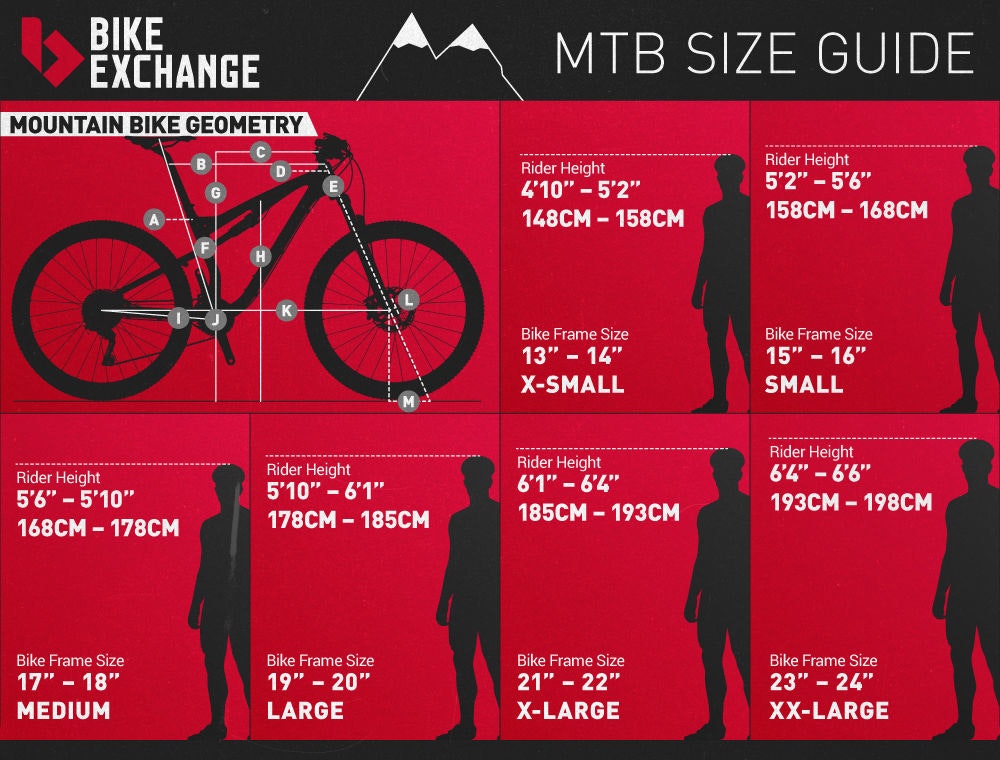
Mountain Bike Accessories
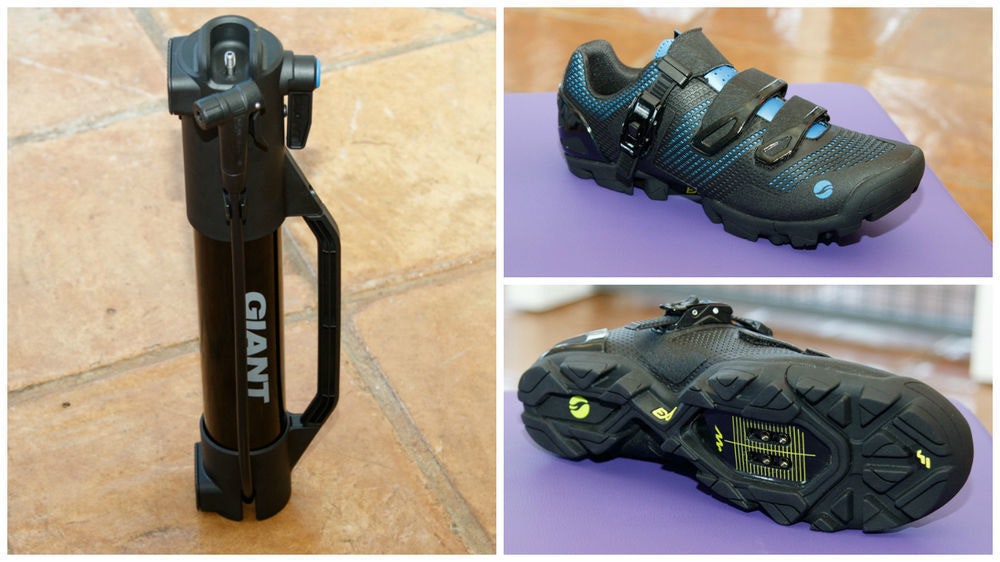
It's important to know that once you've purchased a bike, the job isn't over. Additional purchases in the form of specific pedals, shoes and helmet will still be required. It's worth either putting some additional money aside for these items or trying to get them included in the price of the bike.
Other common accessories that are essential for riding your mountain bike are spare tubes, a hand pump and multi tool. Facility to carry water and your spares in the way of a bottle cage or hydration pack are important too. Padded cycling shorts are a great way to improve your riding comfort, with most mountain bikers preferring the casual look of 'baggy' shorts.
The more technical and risky the mountain biking you plan to do, the more ‘armor’ is usually worn. This can include full face helmets, goggles, limb protection and even neck/spine protection, although these accessories are almost exclusively for downhill riders.
Test Ride
Imagine buying a car without taking it for a test drive first. It's just a given that you test drive a car and a bike should be no different. Only by taking a bike for a ride will you get a feel for it's characteristics, size, geometry and intricacies.
When taking a bike for a test ride, don't just go around the block and make a decision. If possible try to get it for the weekend, or at least try to simulate the type of riding you plan to do. Some brands offer demo shows, where they'll bring an entire fleet of bikes to a trail for you to test (ask your shop). Other shops may have their own demo fleets of popular models to test. Not all shops allow this though, and so you may need to buy a bike based on the advice from trusted resources.
As we've mentioned, the different types of mountain bike riding varies so greatly, the bike you chose must be able to cope with what you have planned. There's no point testing a hardtail mountain bike if you only intend on riding downhill. And testing a cross country bike on flat roads around the shop will tell you nothing about how it will handle single track or steep climbs.
And don't be dazzled by a new shinny bike. Look at it constructively and make an informed decision as to whether or not it meets your needs. If you have doubts at the time of purchase, they will only compound over time.
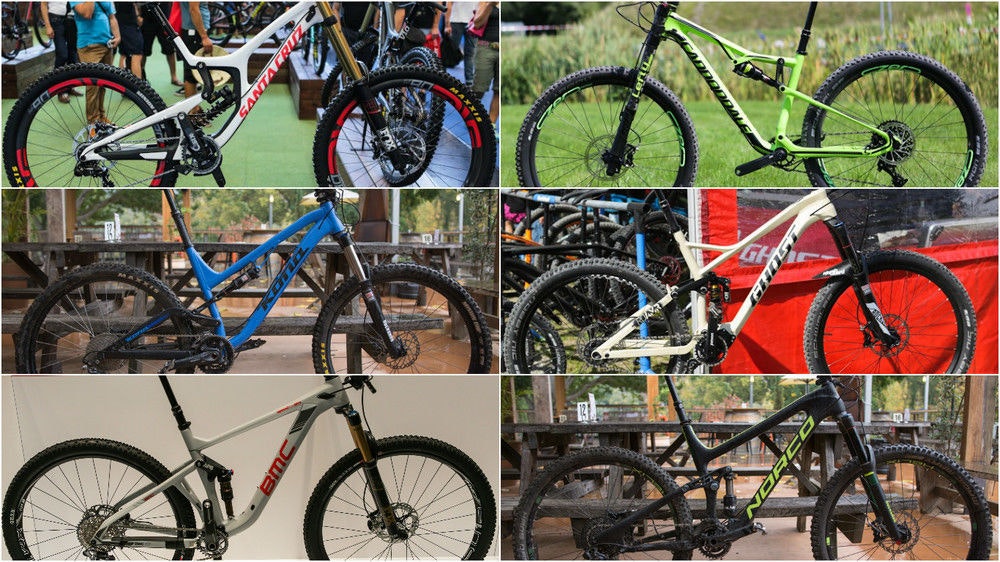
Do some research
To help you make an informed decision, create a list of your top five bikes and do some research.
As well as trawling through cat videos, YouTube can also be used as a quick source of easily consumable information. Look for videos from the manufacturers for specifications and technology information but also look for impartial people or companies providing their opinions.
Look for relevant information that is going to be important to you in the years to come, not just which color is in vogue at the moment. Weight, comfort and safety are all key considerations. Has the bike had any issues or been recalled? What kind of rider is the bike suited to?
If you are looking for a performance bike, ask if it is raced professionally. If it's not, why not? That's not to say for a bike to be good it needs to be ridden by the pro's, but if it's good enough for the professionals, it's highly likely to be good enough for the rest of us.
Look for reviews from other sources too. Magazines, websites, blogs all provide valuable information, normally in much more detail than an online video. And while you're online, look at forums or reviews for information, and be sure to check the comments section at the bottom.
We hope this buyers guide has been helpful and provided some valuable information. You can browse BikeExchange for mountain bikes, or search for your local bike shop to get further assistance.





